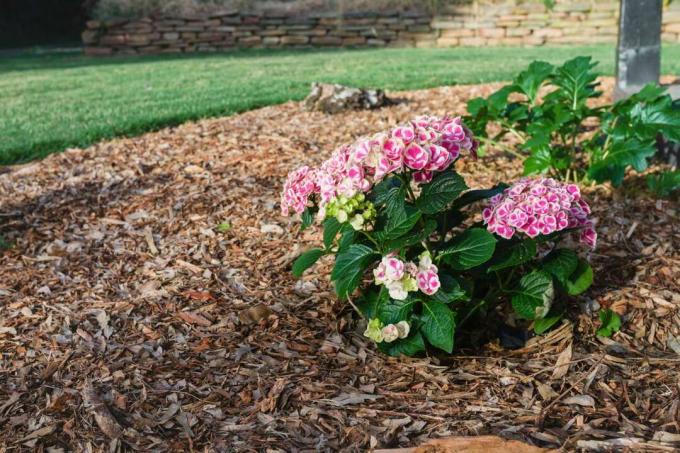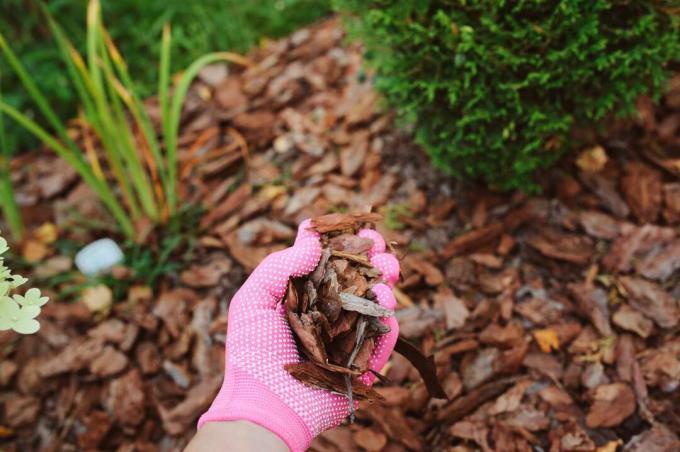Mulching is a tried and tested gardening practice that has many positive effects. Mulching is particularly recommended in hydrangea beds. You can find out why this is so and how exactly you do it here.

Mulching involves spreading a layer of organic, rot-free material on the ground in the flowerbed. Covering the soil has a number of positive effects on the soil, the soil microorganisms and thus also on the plants.
contents
- Mulching hydrangeas: benefits
- The right mulching material for hydrangeas
- Mulch hydrangeas with bark mulch: This is how it works
Mulching hydrangeas: benefits
The main advantage of hydrangea mulching lies in the function of the mulch material as a kind of protective layer for the soil. On the one hand, the covering of the ground acts as an insulation layer and prevents the ground from heating up too much in summer. Neither the hydrangea roots nor the soil microorganisms tolerate this particularly well. In winter, on the other hand, the mulch layer acts as a buffer and protects the sensitive roots from frost damage. Another positive effect of soil cover by mulch is that the soil is protected from drying out. Since the sun does not hit the uncovered earth directly, the moisture is retained in the soil longer. This is a great benefit for the thirsty hydrangea. Apart from that, it is very practical if the bed surface is loose and permeable. Seed weeds cannot emerge so easily here. And if a weed seed does germinate in the mulched bed, it can simply be pulled out of the loose mulch layer.
Furthermore, a layer of mulch prevents soil erosion, as the water is slowed down by the floor covering when it is poured or in heavy rain. This means that the valuable soil is not so easily washed away. Ultimately, the quality and structure of the soil in mulched beds will also improve in the long term.

This is because the organic material serves as food for the soil microorganisms from which they build humus. This ensures that the soil is nice and loose and has an improved function as a nutrient and water store. The decomposition of the biomass also releases long-term nutrients, which in turn feed the hydrangeas and contribute to optimal plant development.
The right mulching material for hydrangeas
There are numerous materials that can be used as mulch. In addition to lawn cuttings, straw, wood chips, coniferous litter or leaves, bark mulch is also very suitable. Hydrangeas, like rhododendrons and blueberries for example, also need an acidic soil pH value in order to be able to develop well. Therefore, when choosing a suitable mulch material, you should ensure that it does not deteriorate the soil quality in terms of pH.
In the hydrangea bed, it is best to resort to an acidic material such as pine bark or coniferous litter. This will prevent the pH of the soil around the hydrangeas from rising to the alkaline range. Another advantage of pine bark is that the material is quite coarse and does not rot as quickly as, for example, lawn or hedge clippings. This way you have a bit of the mulch layer for longer and don't have to renew it as often. In addition, pine bark mulch, like ours Plantura organic pine bark, also enhance the visual appearance of the bed. The pure and natural pine bark comes in a coarse structure and convinces with its decorative color. Since the environment is important to us, our pine mulch is also sustainably produced in the EU.
Mulch hydrangeas with bark mulch: This is how it works
It is important that a so-called compensatory fertilization with a nitrogen-based fertilizer is carried out before spreading the mulch. This fertilizer is only used indirectly for the nutrition of the plants, because it nourishes the soil organisms that pouncing on the mulch material to use it as food and also humus from it build up. If the compensatory fertilization is not carried out, the hydrangeas may develop a nitrogen deficiency, because the organisms must ultimately obtain the vital nutrient from somewhere. Compensating fertilization is carried out with a nitrogen-based fertilizer or with horn meal or horn semolina. The fertilizer is scattered on the ground and not incorporated. The mulch material can be layered directly on top of it.
A hydrangea fertilizer with a high potassium content and iron content like ours Plantura organic hydrangea fertilizer provides your hydrangeas optimally for a rich and long-lasting bloom. But note the most important rule when Hydrangea fertilizing: July is the latest date for fertilizing Hydrangea-Species.
When mulching hydrangeas with bark, a layer of at least 5 cm, better 7 to 10 cm, of the material is applied to the ground. The bark mulch is distributed evenly and evenly between the plants in the bed. The root neck of the hydrangea should, however, be kept free.

If you would like more information about the care, cutting and watering of hydrangeas, we recommend our special article on the subject Hydrangea care.

